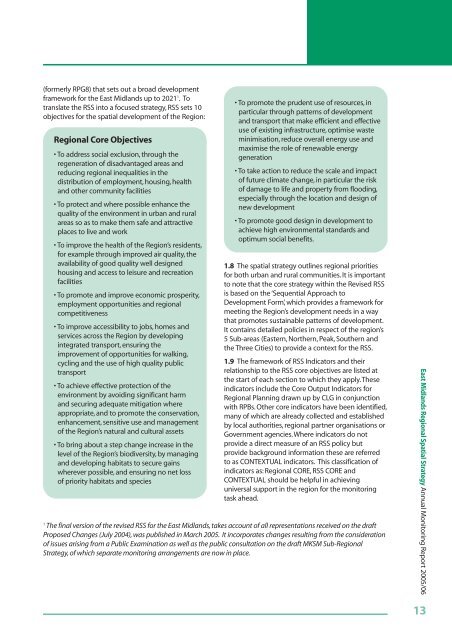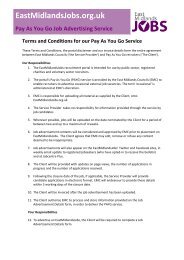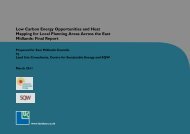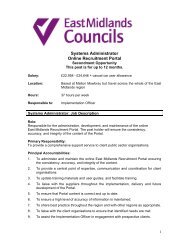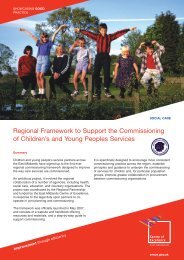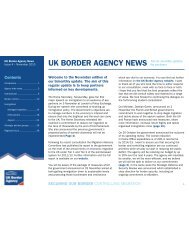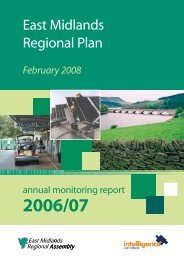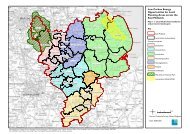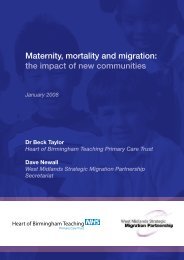East Midlands Regional Spatial Strategy 2005/06
East Midlands Regional Spatial Strategy 2005/06
East Midlands Regional Spatial Strategy 2005/06
Create successful ePaper yourself
Turn your PDF publications into a flip-book with our unique Google optimized e-Paper software.
(formerly RPG8) that sets out a broad development<br />
framework for the <strong>East</strong> <strong>Midlands</strong> up to 2021 1 .To<br />
translate the RSS into a focused strategy, RSS sets 10<br />
objectives for the spatial development of the Region:<br />
<strong>Regional</strong> Core Objectives<br />
• To address social exclusion, through the<br />
regeneration of disadvantaged areas and<br />
reducing regional inequalities in the<br />
distribution of employment, housing, health<br />
and other community facilities<br />
• To protect and where possible enhance the<br />
quality of the environment in urban and rural<br />
areas so as to make them safe and attractive<br />
places to live and work<br />
• To improve the health of the Region’s residents,<br />
for example through improved air quality, the<br />
availability of good quality well designed<br />
housing and access to leisure and recreation<br />
facilities<br />
• To promote and improve economic prosperity,<br />
employment opportunities and regional<br />
competitiveness<br />
• To improve accessibility to jobs, homes and<br />
services across the Region by developing<br />
integrated transport, ensuring the<br />
improvement of opportunities for walking,<br />
cycling and the use of high quality public<br />
transport<br />
• To achieve effective protection of the<br />
environment by avoiding significant harm<br />
and securing adequate mitigation where<br />
appropriate, and to promote the conservation,<br />
enhancement, sensitive use and management<br />
of the Region’s natural and cultural assets<br />
• To bring about a step change increase in the<br />
level of the Region’s biodiversity, by managing<br />
and developing habitats to secure gains<br />
wherever possible, and ensuring no net loss<br />
of priority habitats and species<br />
• To promote the prudent use of resources, in<br />
particular through patterns of development<br />
and transport that make efficient and effective<br />
use of existing infrastructure, optimise waste<br />
minimisation, reduce overall energy use and<br />
maximise the role of renewable energy<br />
generation<br />
• To take action to reduce the scale and impact<br />
of future climate change, in particular the risk<br />
of damage to life and property from flooding,<br />
especially through the location and design of<br />
new development<br />
• To promote good design in development to<br />
achieve high environmental standards and<br />
optimum social benefits.<br />
1.8 The spatial strategy outlines regional priorities<br />
for both urban and rural communities. It is important<br />
to note that the core strategy within the Revised RSS<br />
is based on the ‘Sequential Approach to<br />
Development Form’, which provides a framework for<br />
meeting the Region’s development needs in a way<br />
that promotes sustainable patterns of development.<br />
It contains detailed policies in respect of the region’s<br />
5 Sub-areas (<strong>East</strong>ern, Northern, Peak, Southern and<br />
the Three Cities) to provide a context for the RSS.<br />
1.9 The framework of RSS Indicators and their<br />
relationship to the RSS core objectives are listed at<br />
the start of each section to which they apply.These<br />
indicators include the Core Output Indicators for<br />
<strong>Regional</strong> Planning drawn up by CLG in conjunction<br />
with RPBs. Other core indicators have been identified,<br />
many of which are already collected and established<br />
by local authorities, regional partner organisations or<br />
Government agencies.Where indicators do not<br />
provide a direct measure of an RSS policy but<br />
provide background information these are referred<br />
to as CONTEXTUAL indicators. This classification of<br />
indicators as: <strong>Regional</strong> CORE, RSS CORE and<br />
CONTEXTUAL should be helpful in achieving<br />
universal support in the region for the monitoring<br />
task ahead.<br />
1<br />
The final version of the revised RSS for the <strong>East</strong> <strong>Midlands</strong>, takes account of all representations received on the draft<br />
Proposed Changes (July 2004), was published in March <strong>2005</strong>. It incorporates changes resulting from the consideration<br />
of issues arising from a Public Examination as well as the public consultation on the draft MKSM Sub-<strong>Regional</strong><br />
<strong>Strategy</strong>, of which separate monitoring arrangements are now in place.<br />
<strong>East</strong> <strong>Midlands</strong> <strong>Regional</strong> <strong>Spatial</strong> <strong>Strategy</strong> Annual Monitoring Report <strong>2005</strong>/<strong>06</strong><br />
13


